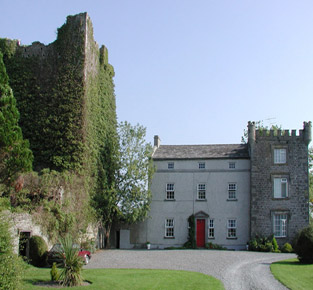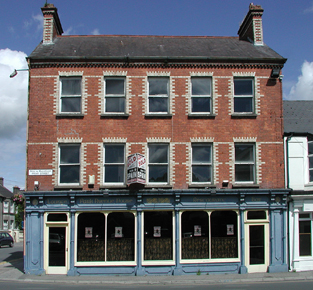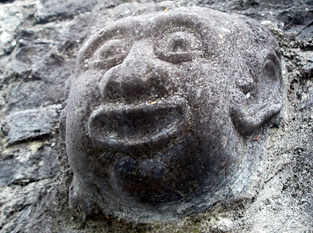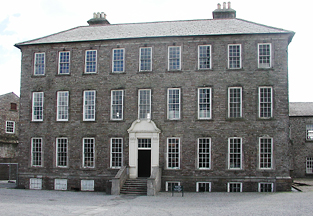Tipperary North


 A particularly interesting aspect of the architectural heritage of North Tipperary is the number of houses that have parts dating to different eras. Many of the houses have a front facade that is of eighteenth- or nineteenth-century appearance. A look at the rear suggests that the bulk of the house or perhaps a rear block is of seventeenth-century or even earlier date. Some of the buildings incorporate medieval towerhouses, others have features such as chimneystacks that project from the gables or the rear wall, suggesting a seventeenth-century date. An early-eighteenth century date can be assigned to elaborate scrolled pediments to doorways and tall narrow small-paned windows. Such houses would repay detailed architectural and archaeological survey. Damer House, Roscrea and Killoskehan House, Templemore are highlighted in the Architectural highlights of North Tipperary.
A particularly interesting aspect of the architectural heritage of North Tipperary is the number of houses that have parts dating to different eras. Many of the houses have a front facade that is of eighteenth- or nineteenth-century appearance. A look at the rear suggests that the bulk of the house or perhaps a rear block is of seventeenth-century or even earlier date. Some of the buildings incorporate medieval towerhouses, others have features such as chimneystacks that project from the gables or the rear wall, suggesting a seventeenth-century date. An early-eighteenth century date can be assigned to elaborate scrolled pediments to doorways and tall narrow small-paned windows. Such houses would repay detailed architectural and archaeological survey. Damer House, Roscrea and Killoskehan House, Templemore are highlighted in the Architectural highlights of North Tipperary.
 Thurles, the largest town in North Tipperary, though not the county town, arguably has its most significant assemblage of architecturally-significant buildings. Liberty Square, at the very centre of the town, is certainly one of the finest urban spaces in Ireland and retains its street frontages largely intact. This square, or rather a long wedge-shaped oblong, was laid out as the market place of the medieval town founded by the Theobald Butlers in the late twelfth century. The only direct approach to the square is Slievenamon Road, at the south side. This street and Parnell Street, leading in at the north-west corner of the square, were both laid out in the 1830s. The other streets all approach the square in gentle curves. At the west end of the square is to be seen the statue of Archbishop Croke, a founder of the Gaelic Athletic Association, which he and others founded in Haye’s Hotel on the north side of the square. At the centre of the square is the 1798 memorial, a limestone figure of a pikeman with a banner over a base which has carved profiles of the leaders of the United Irishmen. Its unveiling in 1900 was a major nationalist event. The coming of the Dublin-Cork railway in 1848 helped to cement the town’s importance. At the east end of the town centre, across the River Suir, stands the ecclesiastical area of the town, boasting the cathedral of the Archdiocese of Cashel and Emly as well as the bishop’s palace, two convents and St Patricks College, the former seminary. The very fine Tudor Revival Stannix Almshouses stand on the Dublin road at the eastern edge of the town. The town also has some good traditional shopfronts.
Thurles, the largest town in North Tipperary, though not the county town, arguably has its most significant assemblage of architecturally-significant buildings. Liberty Square, at the very centre of the town, is certainly one of the finest urban spaces in Ireland and retains its street frontages largely intact. This square, or rather a long wedge-shaped oblong, was laid out as the market place of the medieval town founded by the Theobald Butlers in the late twelfth century. The only direct approach to the square is Slievenamon Road, at the south side. This street and Parnell Street, leading in at the north-west corner of the square, were both laid out in the 1830s. The other streets all approach the square in gentle curves. At the west end of the square is to be seen the statue of Archbishop Croke, a founder of the Gaelic Athletic Association, which he and others founded in Haye’s Hotel on the north side of the square. At the centre of the square is the 1798 memorial, a limestone figure of a pikeman with a banner over a base which has carved profiles of the leaders of the United Irishmen. Its unveiling in 1900 was a major nationalist event. The coming of the Dublin-Cork railway in 1848 helped to cement the town’s importance. At the east end of the town centre, across the River Suir, stands the ecclesiastical area of the town, boasting the cathedral of the Archdiocese of Cashel and Emly as well as the bishop’s palace, two convents and St Patricks College, the former seminary. The very fine Tudor Revival Stannix Almshouses stand on the Dublin road at the eastern edge of the town. The town also has some good traditional shopfronts.
 The following is a sample of the more unusual structures and other items in North Tipperary.
The following is a sample of the more unusual structures and other items in North Tipperary.
 The following selection of buildings and other structures is offered as exemplifying the best of the architectural heritage of North Tipperary.
The following selection of buildings and other structures is offered as exemplifying the best of the architectural heritage of North Tipperary.